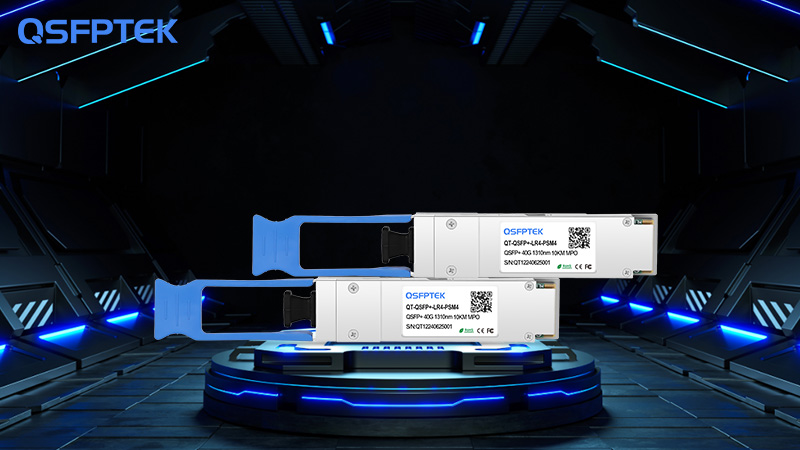As the demand for faster, more efficient data center infrastructure continues to grow, network designers are increasingly turning to high-bandwidth optical solutions that balance performance, cost, and scalability. Among the many 40G transceiver options, 40GBASE-PSM4 QSFP+ stands out as a strong contender—especially for medium- to long-distance single-mode fiber deployments. Offering up to 10km transmission distance over 1310nm wavelength, the PSM4 module brings a unique blend of simplicity, reach, and affordability for next-generation networks.
What is 40GBASE-PSM4?
40GBASE-PSM4 is an 40G QSFP+ transceiver standard based on IEEE 802.3bm, designed to deliver 40Gbps Ethernet over single-mode fiber (SMF). It achieves this by transmitting data in parallel across four 10Gbps lanes, using a 1310nm wavelength. Each of the four transmit and four receive channels operates over a dedicated fiber strand within an MTP/MPO interface, delivering a total of 40Gbps full-duplex throughput.
Unlike short-range solutions like SR4, which are limited to 100–150 meters over multimode fiber, PSM4 offers a reach of up to 10 kilometers—making it suitable for a wide range of data center applications, including long-distance interconnects and campus-wide links.
How Does 40GBASE-PSM4 Work?
The “PSM” in PSM4 stands for Parallel Single Mode, meaning the module transmits and receives four separate 10Gbps signals in parallel across eight individual SMF strands (4 Tx + 4 Rx). Though it uses a 12-fiber MPO connector, only 8 fibers are actively used, while the remaining 4 are left unused or reserved.
This architecture eliminates the need for complex wavelength-division multiplexing (WDM), as found in modules like 40GBASE-LR4. Each lane operates at the same wavelength (1310nm), simplifying the module design and improving cost-effectiveness. The result is a more efficient and lower-power solution compared to alternatives that require internal multiplexing components.
Advantages of 40GBASE-PSM4 in Data Centers
One of the key benefits of 40GBASE-PSM4 is its ability to deliver long-distance connectivity over SMF while maintaining a cost-effective and energy-efficient profile. Because it avoids the internal WDM optics required by LR4 transceivers, the PSM4 module is generally less expensive and consumes less power—an advantage that becomes increasingly valuable at scale.
The 10km reach enables versatile deployment, not only within a single data center but also across multiple facilities in the same campus or metropolitan area. This makes it ideal for long-distance aggregation links, spine-leaf switch connections, or even data center interconnects (DCI) that don’t require the complexity of coherent optics.
Moreover, PSM4’s use of parallel fiber architecture aligns with the same physical infrastructure used for 100G PSM4 deployments. This compatibility provides a seamless upgrade path for data centers planning to migrate from 40G to 100G, reducing future cabling investment and installation time.
Ideal Application Scenarios
40GBASE-PSM4 is especially well-suited to several critical data center scenarios. In leaf-spine network architectures, it serves as a high-bandwidth, medium-to-long-distance interconnect between switches, offering both reach and reliability. Its 10km distance capability means that racks or nodes located far apart—whether in a large building or across a campus—can be connected without needing expensive long-haul optics.
In data center interconnect (DCI) applications, PSM4 offers an attractive option for linking multiple facilities within the same metro or enterprise campus. It supports high-throughput, low-latency communication with minimal cost and deployment complexity.
The module also finds a strong use case in high-performance computing (HPC) environments, where consistent high-speed communication between compute nodes is essential. With its parallel optical design, PSM4 delivers predictable, symmetric performance and reduced crosstalk.
For organizations with existing single-mode fiber infrastructure, PSM4 offers an ideal upgrade from 10G or 1G links, delivering a fourfold bandwidth increase without requiring a full overhaul of cabling systems.
What Sets 40GBASE-PSM4 Apart?
Although many 40G modules exist—such as SR4 for short-range multimode or LR4 for 10km SMF with WDM—PSM4 carves out a distinct niche. Unlike LR4, which uses four different wavelengths over duplex SMF, PSM4 keeps things simple by transmitting the same wavelength in parallel, avoiding expensive WDM optics.
Compared to SR4, which offers a maximum distance of 100–150 meters on OM3/OM4 multimode fiber, PSM4 extends reach dramatically to 10 kilometers, while still using parallel optics for consistent signal quality.
From a design and deployment standpoint, PSM4 also reduces engineering complexity. The uniform wavelength and symmetrical architecture simplify troubleshooting, reduce failure points, and improve maintainability.
Is 40GBASE-PSM4 Future-Proof?
A critical consideration when choosing any data center technology is its longevity—and 40GBASE-PSM4 delivers in that regard. The use of parallel SMF cabling is directly compatible with many 100G and even 400G standards that follow similar architectures (e.g., 100G-PSM4, 400G-DR4). This means that the investment in cabling, connectors, and network planning can extend well beyond 40G, supporting gradual upgrades without major disruption.
As data center speeds increase, the continued industry shift toward single-mode fiber for longer reach and lower attenuation makes PSM4’s design increasingly relevant. With falling SMF costs and broader vendor support, PSM4 is aligned with long-term infrastructure trends.
Additionally, its relatively low power draw and simpler optical components make it easier to integrate into energy-conscious network environments that prioritize sustainability and total cost of ownership.
Conclusion: Is 40GBASE-PSM4 the Right Choice for You?
If you’re designing or upgrading a data center and need a 40G solution that balances reach, cost, and scalability, 40GBASE-PSM4 is a smart choice. Its 10km reach, low power consumption, and simplified optical design make it ideal for a wide range of applications—from core switch interconnects to data center interconnects and HPC.
By eliminating the need for complex WDM components, PSM4 reduces both initial investment and long-term operational costs. And with a forward-compatible cabling approach, it prepares your infrastructure for seamless transition to 100G or higher, safeguarding your investment.
For deployments where single-mode fiber is already in use or where future scalability is a concern, 40GBASE-PSM4 QSFP+ offers the performance and flexibility modern data centers demand.



